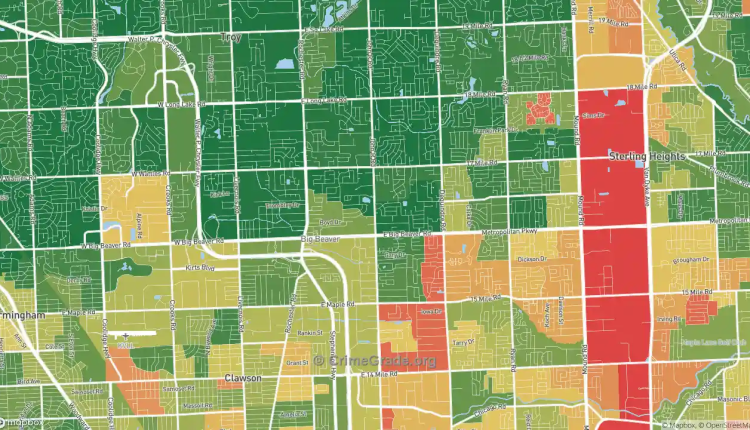Cybersecdn– Troy is in Oakland County, Michigan, and has a population of about 109,874. There is a lot to do in this city, which is known for its great public schools, low jobless rate, and diverse population. Still, Troy has areas with higher crime rates than others, just like any other city. This piece tries to find Troy’s five most dangerous neighborhoods by looking at crime rates, types of crimes, and where the neighborhoods are located.
There are 1,099 serious crimes for every 100,000 people in the city, which is 41% more than the city average and 16% more than the national average. The property crime rate, on the other hand, is 3,734 crimes per 100,000 people, which is 230% more than the city average and 107% more than the national average.
| Neighborhood | Overall Crime Rate (per 100,000) | Violent Crime Rate (per 100,000) | Property Crime Rate (per 100,000) |
| E Big Beaver Rd / John R Rd | 4,833 | 1,099 | 3,734 |
| E Maple Rd / Dequindre Rd | 4,163 | 1,022 | 3,141 |
| E Long Lake Rd / Rochester Rd | 3,489 | 1,016 | 2,473 |
| W Big Beaver Rd / Coolidge Hwy | 3,366 | 1,012 | 2,354 |
| E Wattles Rd / John R Rd | 3,223 | 1,008 | 2,215 |
With 4,163 crimes per 100,000 people, this neighborhood is the second most dangerous in all of Troy. This number is 156% higher than the average for the city and 76% higher than the average for the country.
The rate of serious crime is 1,022 crimes per 100,000 people, which is 24% more than the city average but 7% less than the national average. At the same time, there are 3,141 property crimes for every 100,000 people, which is 182% more than the city average and 88% more than the national average.
Rochester Rd. and E. Long Lake Rd.
With 3,489 crimes per 100,000 people, this neighborhood has the third-highest crime rate in all of Troy. This number is 115% higher than the average for the city and 54% higher than the average for the country.
There are 1,016 serious crimes for every 100,000 people, which is 23% more than the city average but 8% less than the national average. The rate of property crime is 2,473 crimes per 100,000 people, which is 142% more than the city average and 69% more than the national average.
Coolidge Hwy. / W. Big Beaver Rd.

With 3,366 crimes per 100,000 people, this neighborhood is the fourth most dangerous in all of Troy. This number is 108% more than the average for the city and 50% more than the average for the country. The serious crime rate is 1,012 crimes per 100,000 people, which is 22% more than the city average but 8% less than the national average.
The five neighborhoods in Troy City, Michigan that you should avoid are listed below.
The rate of property crime is 2,354 crimes per 100,000 people, which is 135% higher than the city average and 65% higher than the national average.
E Wattles Rd / John R Rd
With 3,223 crimes per 100,000 people, this neighborhood has the fifth-highest crime rate in all of Troy. This is 99% more than the average for the city and 45% more than the average for the country.
The rate of serious crime is 1,008 crimes per 100,000 people, which is 22% higher than the city average but 9% lower than the national average. Property crimes have gone up 127% compared to the city average and 61% compared to the national average. There are now 2,215 crimes per 100,000 people.
Read More: Safety Alert: 5 Neighborhoods You Should Approach with Caution in Lansing, Michigan!
Risk Zones: Navigating Detroit’s 5 Most Challenging Neighborhoods!
Safety Alert: 5 Neighborhoods You Should Approach with Caution in Lansing, Michigan!
To Conclude
Most of the time, Troy is a safe place. Its crime rate is lower than the national average. There are, however, areas with higher crime rates that make living there and visiting even more dangerous.
We used NeighborhoodScout data to find the five most dangerous areas in Troy based on crime rates, types of crimes, and where they are located.
It is recommended that you take extra steps to protect yourself and your belongings if you live or work in these places. Putting in a home security system, locking your doors and windows, and being aware of your surroundings can all be helpful.
Also, it’s important to tell the police about any strange or illegal actions. Working together with the police can help keep your neighborhood safe and reduce crime.

